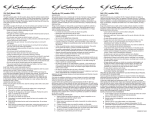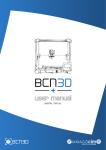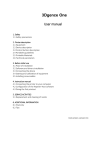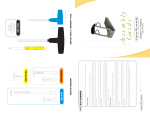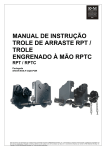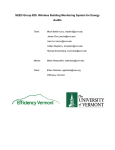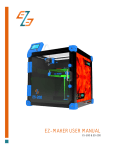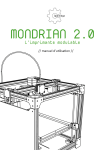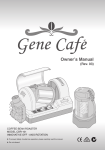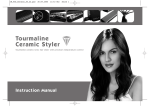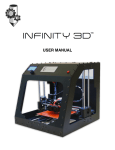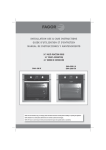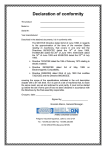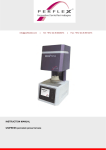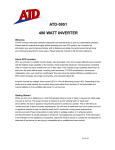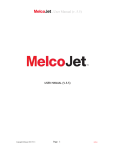Download Quick Start Guide - Downloads
Transcript
Thank you for choosing the LulzBot™ Mini desktop 3D printer and welcome to the LulzBot community. This Quick Start Guide will familiarize you with the proper use and operation of your LulzBot Mini, and by the time you finish, you will have your very own 3D printed rocktopus, the mascot of the LulzBot Mini. Every LulzBot Mini is covered by a one-year warranty and customer support, so if you have questions along the way, please contact us by emailing [email protected] or calling +1 -970-377-1 1 1 1 . Learn more at LulzBot.com/support. Now let's get you 3D printing! Read the included User Safety Sheet completely before beginning the Quick Start. Find the full user manual for your LulzBot Mini online at LulzBot.com/Mini. STEP 1 Unpack Your LulzBot™ Mini Desktop 3D Printer 1a Carefully remove the top piece of protective foam and other included materials. Then place your LulzBot Mini on a flat and level surface with 30 centimeters (1 2 inches) of clearance in every direction. Your LulzBot Mini comes with an octopus that was made by your 3D printer during the final stage ofquality assurance. Several tools for maintaining your LulzBot Mini are also included. Learn more about how to use them in the maintenance section at the end ofthis Quick Start Guide. 1B Remove all packaging foam and confirm everything on the Packing List is included in the box. Save all of the provided packaging materials in case you need to transport your 3D printer in the future. ON OFF STEP 2 Download and Install the Software for Your LulzBot™ Mini Visit LulzBot.com/Cura to find download and installation instructions for Cura LulzBot Edition, the software that will control your 3D printer. Even if you already have Cura installed on your computer, visit LulzBot.com/Cura anyway to get the latest version of Cura LulzBot Edition. Unable to download Cura LulzBot Edition from the Internet? You can also find installation packages on the included USB thumb drive that comes with your LulzBot Mini. STEP 3 Configure Cura LulzBot Edition for Your LulzBot™ Mini 3A Launch Cura LulzBot Edition. Begin the Configuration Wizard and select LulzBot Mini and click Next. In the Tool Head Selection window select Standard LulzBot Mini and click Next. 3b Click Finish to complete the Configuration Wizard. Cura LulzBot Edition is now installed and ready for use. STEP 4 Connect and Power On Your LulzBot™ Mini ON OFF Check that the power switch is off Connect the USB cable ON OFF Connect the power cord Power on STEP 5 Prepare the Model for Your First 3D Print 5A A 3D model named rocktopus will automatically load onto Cura LulzBot Edition's virtual print bed the first time you run the software. The rocktopus is the first object you will 3D print on your LulzBot Mini. Ifthe rocktopus model is not present on the virtual print bed, you can download it from LulzBot.com/rocktopus or from the included USB thumb drive, then load it using the LoadModel button in the main Cura interface. 5B Locate the included 1 meter (40 inch) green or yellow coil of HIPS sample filament. We strongly recommend using the included HIPS sample filament for your first rocktopus 3D print. Filament is the name for the materials your LulzBot Mini uses to 3D print objects. The included sample filament is a plastic known as High Impact Polystyrene, or HIPS. STEP 5 Continued... 5C On the left side of the screen under “Material,” select HIPS (eSUN) . Then under "Select a quickprint profle," select Standard . STEP 6 Control Your LulzBot™ Mini and Set the Temperature 6A Using your computer, click the Control button on the main Cura interface. A new window called the Printer Interface will open. Ifthe Control button does not appear, verify that the drivers fully installed during Step 2. Reinstall Cura ifnecessary. STEP 6 Continued... Your LulzBot Mini is tested for quality assurance before being packaged. You will need to remove the remaining filament left in the tool head from this process before loading new filament for your next print. 240ºCis the required hot end temperature to remove HIPS from the tool head. See Step 14 for the required temperature for other materials. 6B Using the Printer Interface window, raise the hot end temperature up to 240ºC by typing 240 under “Temperature,” then clicking Set in the Printer Interface window. Monitor the current printer temperature using the status bar at the top of the Printer Interface window. Temperature Status Temperature Control The hot end is now heating up to 240ºC(464ºF) and can burn your skin. HIPS Filament Hot End Very hot! Do not touch! STEP 7 Lower the Hinged Idler and Remove Loaded Filament 7A Locate the tool head of your LulzBot Mini. Using the idler retainer, compress the springs with your thumb and slide up, allowing the hinged idler to move freely. Then lower the hinged idler counter-clockwise. Idler Retainer Hinged Idler 7B Wait until the status bar of the Printer Interface shows the Temperature has reached 240ºC. 7C Once the Temperature has reached 240ºC, pinch the HIPS filament loaded in the tool head and remove it by pulling up. HIPS Filament STEP 8 Prepare and Load Filament 8A Face the front of your LulzBot Mini. Find the filament holder, which is mounted to the top right corner of the printer frame. Rotate the filament holder counter-clockwise into an upright and locked position. Filament Holder ON OFF 8B We strongly recommend using the included 1 meter HIPS filament sample for your first rocktopus print. Mount the HIPS filament sample on the filament holder so the filament can feed down into the tool head. HIPS Filament Sample Tool Head ON OFF STEP 8 Continued... 8C Locate the feed hole in the extruder body where you removed the loaded filament during Step 7. Filament feeds through this hole and down into the hot end for printing. The hot end is still heated to 240ºC(464ºF) and can burn your skin. Tool Head Feed Hole ON OFF 8D Make sure the idler retainer is touching the springs so it is out of the way. Then push the HIPS filament down into the feed hole in the extruder body and through the hot end until a small amount of filament comes out of the tip of the nozzle. The HIPS filament sample should travel approximately 100 millimeters (4 inches) down through the extruder body and into the hot end. Idler Retainer Feed Hole STEP 9 Raise the Hinged Idler Using your thumb, compress the springs with the idler retainer and rotate the hinged idler clockwise into an upright position. Lock the hinged idler into place by sliding the idler retainer back down. Idler Retainer Hinged Idler STEP 10 Verify Print Extrusion 10A Make sure your LulzBot Mini is ready for printing by verifying the printer's ability to extrude filament. Using your computer, click the Extrude 1 0 button in the Printer Interface and look for filament to feed through the nozzle. Extrusion is the term for when filament feeds through the tool head and out the nozzle. STEP 10 Continued... 10B If you do not see filament coming through the nozzle and the drive gear stops moving, click the Extrude 1 0 button once more and wait. Repeat as needed until you see consistent and repeatable extrusion. Extruded Filament 10C Wait ten seconds for the filament to cool, then remove the extruded filament with the included tweezers. STEP 11 Start Your First Print Wait! Are you sure you are ready to print? Check one final time to make sure you removed all the packaging foam from your LulzBot Mini during Step 1. Did you make changes to your object on the virtual print bed after opening the Printer Interface window? Ifso, you will need to close the Printer Interface window and click Control again to incorporate these new changes. STEP 11 Continued... 11A Click Print in the Printer Interface window to start your first 3D print, then watch your LulzBot Mini automatically prepare itself for 3D printing. 11B Your LulzBot Mini will first move its tool head to the top left corner and allow the hot end to cool down prior to starting its cleaning process. Depending on ambient air temperature, this can take 2-5 minutes. 11C The tool head will then move to the back of the bed to clean off the nozzle. After cleaning, your LulzBot Mini will conduct an automated self-leveling sequence, heat up to final temperature, and start printing. This process can take approximately four minutes. Nozzle Cleaning Bed-Leveling Sensors Watch the self-leveling sequence every time. The nozzle should very lightly touch each ofthe four corner pads. Ifit presses down hard on any corner, power offthe 3D printer and restart the print to allow a second cleaning pass. 11D Watch as your very own rocktopus is made before your eyes! The total print time can take approximately 35 minutes. STEP 12 Remove Your 3D Printed Object 12A After your LulzBot Mini is finished 3D printing, the tool head and print bed will automatically move into the cooling position (with the tool head in the top left and print bed set back). Cooling Position ON OFF Your printer is now actively cooling. Do not attempt to remove your 3D printed object before the print bed moves forward. Attempting to do so could either burn your skin on the hot end or print bed, damage your printer, or damage your 3D printed object. 12B Once finished cooling, the tool head will move to the top right and the print bed will move forward. After the print bed moves forward, remove the thin outer print layer. Then remove your rocktopus by lifting gently underneath it with the included bluehandled knife. Carefully pry under each tentacle, then slide the blade under the center beneath its head. The blade ofthe blue-handled knife is very sharp, so exercise caution when using it. The blade should be nearly parallel with the print bed. Carefully pry away from the bed, with the sharp edge between the object and print bed. STEP 13 Rock On Congratulations! Now that your LulzBot Mini Desktop 3D Printer is up and running, share your 3D printing skills on social media using #rocktopus. Don't forget to tag us in your post, then follow us for the latest news. You can find LulzBot on Twitter, YouTube, Facebook, Google+, and LinkedIn. Next, join us on the LulzBot Forum at Forum.LulzBot.com! Need ideas for what to print next? Get inspired by starter projects available at LulzBot.com/next. STEP 14 Your Next Print 14A There is a small length of the HIPS filament sample remaining in the hot end after your first rocktopus print. You can remove this remaining filament by following Step 6 and Step 7. After removing filament (as outlined above), a small residual amount remains in the hot end that needs to be cleared out through a process called purging. 14b If you plan to use a filament other than HIPS for your next print there may be a difference in the temperature required for purging the residual filament in the hot end, and then 3D printing with the new filament. In the FilamentReference Guide on the following page, identify the higher purge temperature between the two filaments (both the one you need to purge, and the new filament you want to print with). Using the Printer Interface window, set the hot end to the higher printing temperature between the two filaments. Load the new filament following the procedure in Step 7. STEP 14 Continued... Filament Reference Guide Filament Purging Temperature (˚C) Safe Print Bed Temperature for Part Removal (˚C) Print Bed Preparation (See maintenance section for more information) ABS, HIPS 240 50 Isopropyl alcohol wipe PLA 205 45 Isopropyl alcohol wipe Magnetic Iron and Stainless Steel PLA 230 50 Isopropyl alcohol wipe Laybrick, Laywoo-D3 1 90 50 PVA glue stick n-vent, t-glase 240 50 PVA glue stick Bridge, PCTPE, 91 0 240 60 PVA glue stick Your LulzBot Mini desktop 3D printer is capable of printing in even more advanced and expert level filament materials including: Conductive PLA, PC-ABS, polycarbonate, PVA, 61 8 Nylon, 645 Nylon, and more. Plus, we add new materials to our catalog frequently. Explore our full range of filaments by visiting LulzBot.com/filament Selecting the higher temperature between the two filaments is important, otherwise you may lower the quality ofyour next print or even clog the nozzle. 14C Purge the residual filament that remains in the hot end using the Extrude 1 0 button, as shown in Step 1 0. Wait until the drive gear stops moving and repeat as needed until you see consistent and repeatable extrusion of the new filament. 14D Turn off the hot end by setting temperature to 0˚C , then close the Printer Interface window. You must close the Printer Interface window before proceeding so that the file information for your next print in Step14Eis captured. STEP 14 Continued... 14E Clear the virtual print bed by right clicking (or holding control and clicking) the rocktopus model and selecting Delete Object. Then upload the new model that you want to print next by clicking Load Model in the main Cura Interface. 14F With your new object set, re-open the Printer Interface window by clicking Control in the main Cura interface and set the final temperature using the recommended temperatures from the FilamentReference Guide in Step 1 4B. Once the printer reaches temperature in the status bar, click Print. 14G Follow the object removal instructions outlined in Step 1 2. Maintaining Your LulzBot™ Mini Desktop 3D Printer Warranty and Support Your machine comes with a comprehensive one-year warranty and customer support period. For more information please visit us at LulzBot.com/support. Source Files This product is licensed as Open Source Hardware and runs with Free Software because we respect your freedom to see how it works, make modifications, and share your modifications with others. Find the source files online at Download.LulzBot.com , and see what's next by following our research and development online at Devel.LulzBot.com . Filament Materials Your LulzBot Mini utilizes an open format filament system. We strongly recommend you purchase your 3D printing filament materials from LulzBot.com, where every filament has been thoroughly tested to work on your printer and comes with optimized default settings for easier printing. If you choose to purchase elsewhere, avoid low quality filaments that can lead to failed prints and even damage our LulzBot Mini. Low quality filament can contain foreign objects, unlisted materials blends, voids and density variations, and varying filament diameter. Purchasing consistent and reliable filament is key, and well worth it to protect your investment in a LulzBot desktop 3D printer. Nozzle Wiping Pad Over time your nozzle wiping pad will need to be replaced. If in observing the nozzle wiping sequence the cleaning appears to be less effective, and is leaving more filament residue on the nozzle, be proactive in replacing the nozzle wiping pad. This process is vital to the continued functioning of your LulzBot Mini. A clean metal surface on the nozzle is critical for the automated bed leveling process to be successful. Continued... Replacement time for the nozzle wiping pad will vary depending on the types of materials you are 3D printing with. Several spares are included with your LulzBot Mini, and additional nozzle wiping pads are available for purchase online at LulzBot.com . Print Bed Make sure that the hot end and print bed are completely cooled and at room temperature before beginning any cleaning or maintenance of the print bed. Your LulzBot Mini has a PEI print surface, which helps printed objects adhere to the bed. Note that the oil on your skin can negatively affect print adhesion. For optimal performance, lightly wipe the print bed with a dry paper towel between prints. If you start seeing adhesion issues and your prints are not sticking to the print bed, carefully wipe the bed with isopropyl alcohol, which you can purchase from your local pharmacy. A light and gentle sanding with fine (2000-3000 grit) sandpaper is also helpful, which you can purchase from your local hardware store. For some filaments a polyvinyl alcohol (PVA) glue stick, such as UHU® brand glue stick is necessary for bed adhesion. Tool Head Cleaning Make sure that the hot end and print bed are completely cooled and at room temperature before beginning any cleaning or maintenance of the tool head. Included with your printer you will find a dental pick and thin wire brush for cleaning the hobbed bolt component of the tool head. (The hobbed bolt is the small grooved metal part of the tool head that feeds filament into the feed hole.) Over time you may also experience an accumulation of filament on the nozzle and heater block. To clean up this accumulated filament, heat the hot end up to 1 80ºC (356ºF) and then carefully wipe affected areas using a clean dry cotton cloth.
































